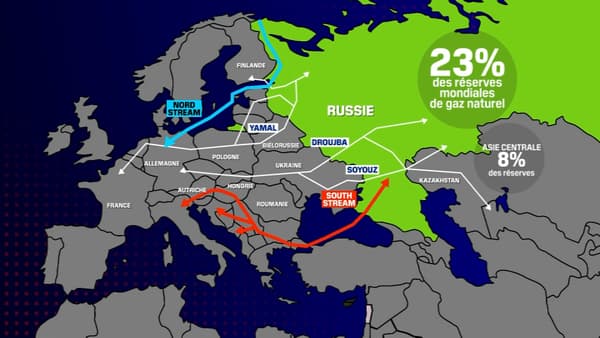The Nord Stream 1 and 2 gas pipelines, which connect Russia with Germany under the Baltic Sea, have been the victims of leaks possibly related to explosions since Monday. The two gas pipelines, operated by a consortium dependent on the Russian giant Gazprom, are not operational due to the consequences of the war in Ukraine, but they were full of gas.
• Leaks in two different gas pipelines
This Monday, gas leaks were detected in the Nord Stream 2 gas pipeline, which connects Russia with Germany but which was not put into service. Just before the announcement of this incident on the Danish side, the German Economics Ministry had announced that it was investigating a rapid and unforeseen “pressure drop” in the Nord Stream 2 gas pipeline.
On Tuesday morning, the Nord Stream 1 pipeline was affected by two gas leaks, Danish authorities reported. The three main leaks identified since Monday are off the Danish island of Bornholm, between southern Sweden and Poland. They are visible on the surface with bubbles ranging from 200 meters to 1 kilometer in diameter, the Danish military announced on Tuesday, with impressive supporting images.
Like the leak noticed the day before on Nord Stream 2, security measures have been taken. Nord Stream 1 was commissioned in 2012 and Nord Stream 2 has never been used.
The Danish government estimates that the leaks in the pipelines should last “at least a week” until the exhaustion of the methane that escapes through the underwater pipelines.
• Underwater explosions detected
On Tuesday, a Swedish seismic institute said two underwater explosions “probably due to detonations” were recorded near the sites of the Nord Stream 1 and 2 pipeline leaks shortly before they were detected.
A first “massive energy emission” with a magnitude of 1.9 was recorded during the night from Sunday to Monday at 02:03 a.m. southeast of the Danish island of Bornholm, then another of magnitude 2.3 at 7:00 p.m. 04 hours on Monday night in the northeast of the island, Peter Schmidt, of the Swedish National Seismic Network, told AFP.
The Independent Seismological Institute of Norway (Norsar) confirmed after having also registered “a small explosion” early Monday and another “more powerful” on Monday afternoon, which it suspects was deliberate.

• Russia accused of sabotage
These explosions, coupled with the leaks, in a tense geopolitical and energy context, immediately aroused suspicions of sabotage.
“It’s an explosion of meaning. It’s tempting to think it was the work of someone who knew what they were doing,” Norsar director Anne Strømmen Lycke told AFP.
The Danish Prime Minister thinks no different. “The clear opinion of the authorities is that these are deliberate acts. We are not talking about an accident,” Mette Frederiksen said Tuesday night. She added that she had no information on who was responsible for the incident.
The Copenhagen conclusion is based in particular on the fact that the holes through which the gas escapes are “too big” to be of accidental cause and that they were caused “by detonations”, detailed Energy Minister Dan Jørgensen.
In fact, Ukraine very quickly accused Russia, through the voice of the presidential adviser, Mykhaïlo Podoliak. He denounced on Twitter a “planned terrorist attack” by Russia “against the European Union.”
The Kremlin spokesman said he was “extremely concerned” about these leaks and said on Tuesday that “no” hypothesis should be excluded, including sabotage.
• A gas pipeline at the center of geopolitical tensions
Built in parallel to the Nord Stream 1 pipeline, the Nord Stream 2 pipeline was intended to double the capacity to import Russian gas to Germany. But its imminent start-up has been put on hold by Germany due to Russia’s invasion of Ukraine.
Gazprom also gradually reduced gas volumes delivered by Nord Stream 1 until the pipeline was completely shut down in late August, blaming Western sanctions for delaying necessary repairs to the pipeline. Before the start of the war, Germany imported 55% of the gas it consumed from Russia. This was still the case for 26% of the gas consumed at the end of June, according to the German government website.
At the European level, these gas pipelines are the symbol of Russia’s energy dependence. “In 2020, the EU depended mainly on Russia for its imports of crude oil, natural gas and solid fossil fuels,” underlines the statistical institute Eurostat. Ukraine also opposed the Nord Stream 2 project, seeing it as a “geopolitical weapon” for Russia.
Source: BFM TV

